My Love of this Place is So Transparent
New Canaan (Google Maps location)
August 1, 2009
Finally. A visit to the Glass House.
Finally. (This was one of the most anticipated visits in the history of CTMQ.)
Finally. (I tried to get a Saturday tour here for two years before I finally did.)
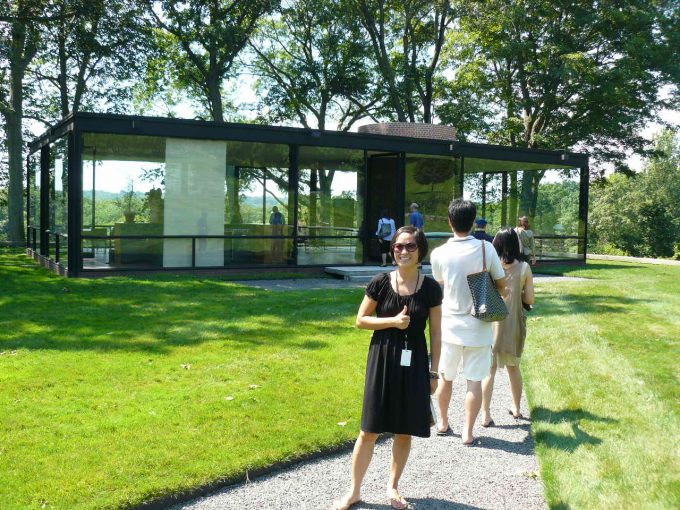
Finally. And maybe someday, I’ll dig out the old CD-R with the original photos on it to upload bigger pictures like the one above. Honestly, of the thousands of pages on CTMQ with bad pictures, this one drives me the craziest. Hands down.
Philip Johnson’s Glass House tours are were among the hardest tickets to get for anything in the entire state. This fact is both encouraging and confusing. Encouraging because it tells me that there are people who understand and appreciate modern architecture, but confusing because… well, because there are people here who understand and appreciate modern architecture?
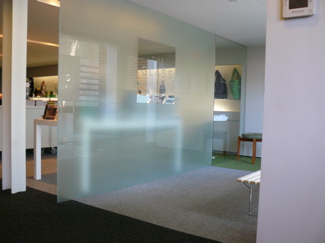
Tours are limited (but available now, unlike in the House’s first few years) and they usually sell out. I was fortunate to have scored four tickets to a Saturday Extended Tour at 45 bucks a pop, thus making this one of the most expensive museum experiences in the state.
You can do other things here that cost many hundreds of dollars if you wish. (Special tours, picnics, trips down to Philip Johnson’s Four Seasons in Manhattan, etc.)
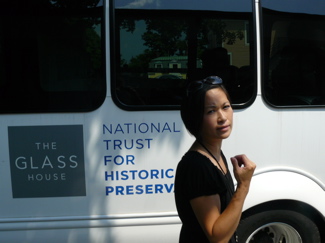
And so, on a perfect day weather-wise, I was joined by Hoang and our friend Caroline as well as her friend Dehryll. There is a LOT going on here, with several distinct buildings on the property service different purposes. And there is a lot of Glass House information “out there” available to us all.
As a favor to you, you can stop reading my page now and just read this lecture on the Glass House by Paul Goldberger and then go visit yourself. For those of you intrepid CTMQsters, a bid you good luck as you plunge ahead…
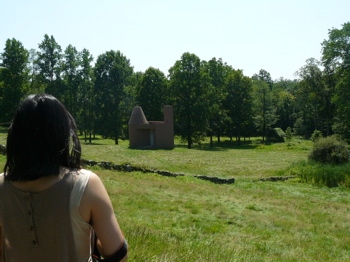
As I mentioned, there are several other buildings on the property that are almost all separate museums in their own right, including an art gallery and a sculpture gallery. So even if you have some weird hang-up about the house itself, you could still enjoy yourself in the other buildings. They are ALL awesome.
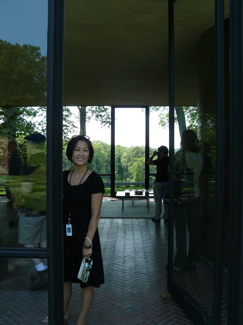
The Glass House is a National Historic Landmark – one of only 63 in Connecticut. As of 2019, it’s the only “modern” one on the list in Connecticut and here’s the kicker: My wife, the one and only Hoang, actually worked on the NHL accreditation! Yes, in a previous life, Hoang’s job took her to the corners of the state photographing various historically important sites and buildings for preservation reasons. Johnson set it up before his death so that his house would be forever preserved, and it makes me proud that Hoang had a hand in that. Her original photos are part of the historic record for the Glass House.
Here’s one from the NHL nomination:
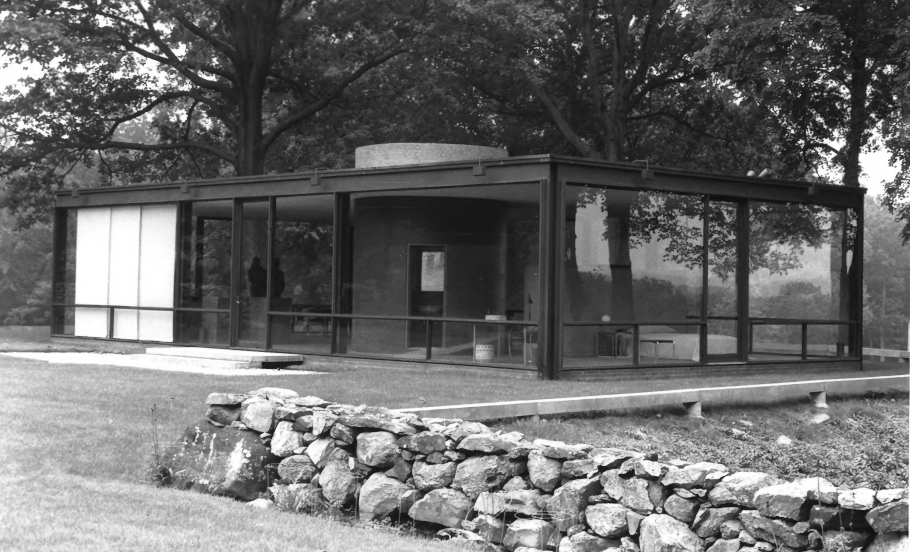
Cool, huh? Here’s another:
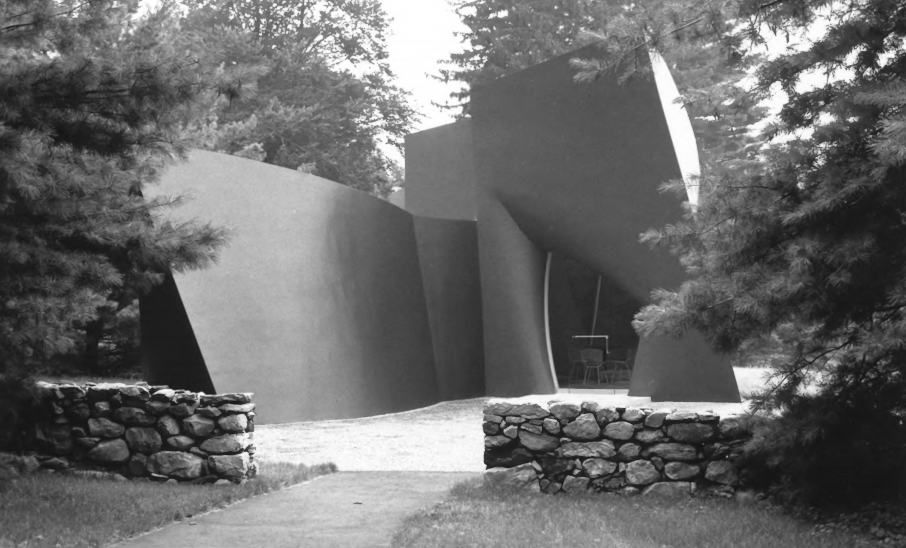
Here’s her NHL Nomination form with some more pictures she took – and captions she wrote here.
Someday I’ll save up enough money to take the New Canaan Modern House tour. For a few hundred bucks, you get to shuttle around town and take in a bunch of the moderately famous moderns. There are a ton down here, many of them architecturally and historically significant.
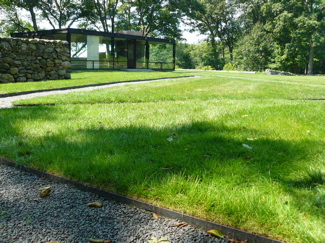
I won’t bore you too much with the history, but there’s a reason for the concentration of moderns in New Canaan: The Harvard Five. They were a group of architects that settled in New Canaan in the 1940’s: John M. Johansen, Marcel Breuer, Landis Gores, Philip Johnson and Eliot Noyes. Marcel Breuer was an instructor at the Harvard Graduate School of Design, while Gores, Johansen, Johnson and Noyes were students there. They were all influenced by Walter Gropius, a leader in the Bauhaus movement and the head of the architecture program at Harvard.
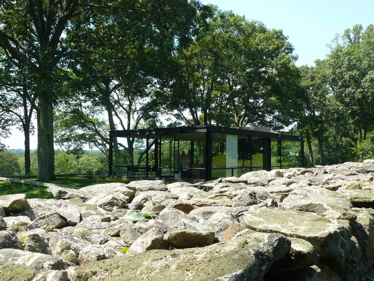
The small town of New Canaan is nationally recognized for its many examples of modern architecture. Approximately 100 modern homes were built in town, including Johnson’s Glass House, and “only” about 20 have been torn down.
I personally love Eliot Noyes’ work. But I’m digressing. On the day of the tour, we met at the visitor’s center in “downtown” New Canaan. There is a gift shop there and some displays about Johnson and the Harvard Five. At the appointed hour, we hopped on the little tour shuttle and drove out into the country where the house is. (Important mid-century buildings along the way were pointed out.)
Upon arrival and disembarking at the property, anyone who thought we were just going to see a glass house was quickly corrected. Every building here is a work of art in its own right – even the gate through which we passed.
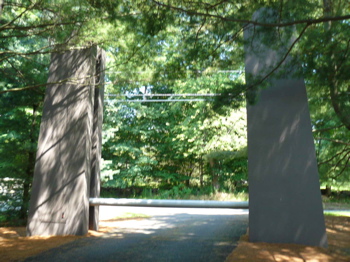
It’s a cool gate, but as you can surmise, there is a limit to what can pass beneath it. I don’t recall the reason for this shortsightedness, but the thing works via remote control and the bar raises and lowers like a curtain – as if you’re about to see a show. Which, of course, you sort of are.
Our guide took us to a shaded area to gaze out upon some of the buildings we wouldn’t be visiting. The property contains several buildings and art projects, spanning (literally) fifty years of modern design. Johnson bought the land in 1945 and the last building, Da Monsta, was completed in 1995. (The aforementioned gate, by the way, was completed in about 1980.)
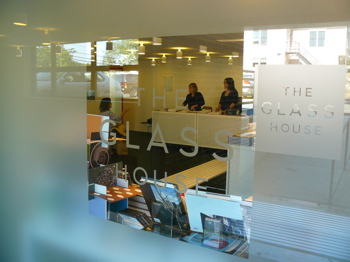
Basically, Johnson was a bit of a goofball who always admitted two things: Most of the buildings here in New Canaan were more or less conceptualized experiments. He never aspired to be some super-minimalist with the Glass House, nor did her pretend that all his work here is super-original OR super-livable. But, lots of thought went into each building, of course.
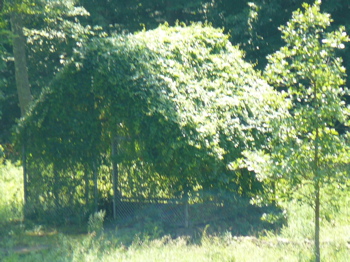
The Ghost House
In 1984, the Ghost House was completed. Not a house at all really (except for birds I guess), but more a living work of art. The Ghost House is made of a galvanized-steel frame with chain-link fencing. The structure consists of two identical halves that do not meet in the middle but leave a gap wide enough for a person to pass through sideways and narrow enough to keep out deer. What’s cool about it is that it changes with the seasons – we were shown a book that featured beautiful photos of it in the fall and winter.
As we made our way towards the Glass House, we passed a really cool wall sculpture about which I’ve completely forgotten the details. The way it sort of conformed to the slight undulations of the land was really interesting. We were told some crazy story about how it came to be, but I unfortunately forget it. Sorry.
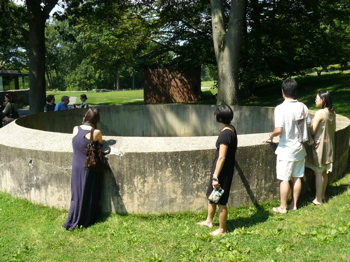
The Brick House was closed for renovations, unfortunately. I have as much interest in it as the Glass House. Obviously built to sort of juxtapose the glass house right in front of it, it’s boring exterior masks a beautiful, soft interior. (It was built at the same time as the Glass House.) In fact, Johnson considered the Glass and the Brick Houses as one unified property; carefully and artfully constructing the gravel paths between the two structures to connect them, as if by a hallway.
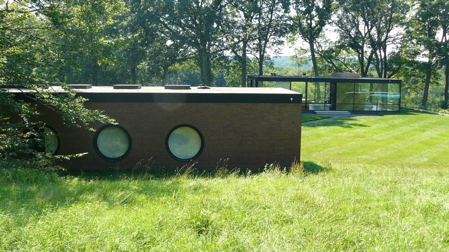
From behind the Brick House
Here’s some info on the Brick House from someone smart:
The Glass House and the Brick House offer a lesson of contrasts. Designed at the same time, the Brick House was completed a few months before the Glass House. A grassy court links the two buildings conceived of as a single composition. Both houses are 56 feet long; however, the Brick House is only half as deep as the Glass House. The Brick House contains all the support systems necessary for the function of both buildings. As opposed to the transparency of the Glass House, brick almost completely encases the house.
The only windows, with the exception of the skylights, are large circular forms at the rear of the building. According to Johnson, this series of round openings alludes to Filippo Brunelleschi’s fifteenth century Duomo in Florence. Johnson remodeled the interior of the Brick House in 1953. Originally there were three equally-sized guest rooms, but now a narrow skylit corridor connects a bedroom and reading room.
The low, sleek, white vaults that decorate the bedroom are based on the breakfast room of the Sir John Soane House in London completed in 1824, and are harbingers of laments later found in Johnson’s original design of the synagogue for the Congregation Kneses Tifereth Israel in Port Chester, New York and later at Lincoln Center. The room is covered in a patterned silk fabric designed by Fortuny. Prints by Brice Marden line the corridor, and the reading room consists of Johnson’s library of philosophy, history, and art history books.
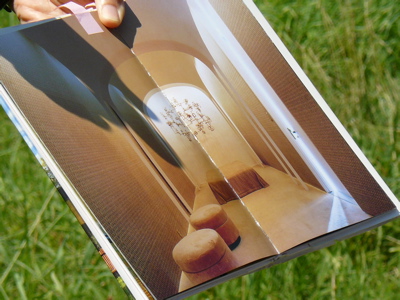
Inside the Brick House
I saw an interview once wherein Johnson called the bedroom the sexiest room he’d ever seen. Amazing what he “hid” in this brick rectangle directly in view of the “open” Glass House. I’m sure we’ll revisit the property someday and hopefully get inside the Brick House.
There’s a small pool between the two houses, but it’s a mere afterthought on the way to the Glass House. Let’s dispense with a few commonly heard refrains about the house:
Yes, there is a fully functioning bathroom. It is “hidden” and very private, built into the back of the central chimney structure.
No, there are no curtains – but there are no neighbors either. Privacy is achieved here by location, not fabric. And really, Johnson was a skinny old man; no one was sneaking a peak. Of course, Hoang says she’d live in a similar house in a heartbeat, in which case I think there may be a few more interested peepers.
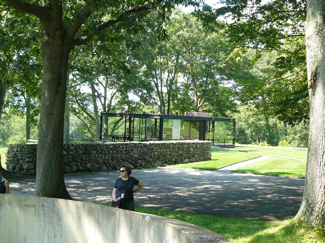
Yes, Johnson readily admits the inspiration for the house was from his friend Mies van der Rohe’s Farnsworth House. (He saw the plans before it was built and “beat” van der Rohe to the Glass House punch. In fact, the furniture in the Glass House is all van der Rohe; and the bed was designed specifically for him by his friend and went on to be a huge success for van der Rohe.) Da Monsta and the Ghost House were inspired by his friend Frank Gehry. Johnson never pretended these things were more than they were. Our guide called this place Johnson’s 50 year experiment. Johnson called the site his “50-year diary.”
I should also mention that Johnson was an, um, interesting man. Gay, American, and artistic, he dabbled in Nazi stuff at some point. He naturally disavowed all of that, but you know, it happened.
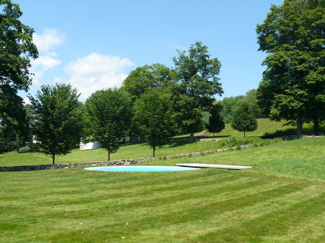
And finally yes, one could feasibly live in the Glass House if one chose to, but that was hardly Johnson’s intent. His library is housed in another building along with guest rooms, art work, comfy couches, televisions, etc.
I’ll leave it to some experts to better set the scene.
Paul Heyer wrote,
Philip Johnson, one of the early advocates of the Modern Movement in the United States and one of the first architects to point to its shortcomings in the fifties, designed, in his own Glass House, one of the world’s most beautiful yet least functional houses; it was never envisioned as a ‘home’ (house) to live in but a life-style stage to live with. Ostensibly entirely in l’esprit nouveau of the Modern Movement, it was a building really expressing many concerns of classic design, from the elevated placement of an object in a space, to its serene proportion, general overall symmetry, and combining of a balance of elements with a meticulous refinement of detail…
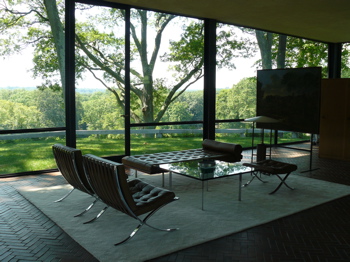
Better yet, let’s let Philip Johnson have a paragraph or two:
The painters have every advantage over us today…Besides being able to tear up their failures—we never can seem to grow ivy fast enough—their materials cost them nothing. They have no committees of laymen telling them what to do. They have no deadlines, no budgets. We are all sickeningly familiar with the final cuts to our plans at the last moment. Why not take out the landscaping, the retaining walls, the colonnades? The building would be just as useful and much cheaper. True, an architect leads a hard life—for an artist.
…Comfort is not a function of beauty… purpose is not necessary to make a building beautiful…sooner or later we will fit our buildings so that they can be used…where form comes from I don’t know, but it has nothing at all to do with the funcitional or sociological aspects of our architecture.
So you see, Johnson DID NOT design and build this place as a comfy li’l country home. That was not the point! Stop trying to make it the point! Just enjoy the dang thing for what it is: A beautiful, if simple, artistic statement. The views from it –and of it – are beautiful. They do serve a function!
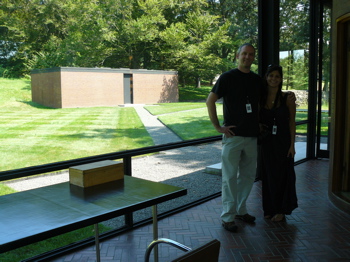
Speaking of views, out the back and down the hill from the Glass House are two more interesting structures. One, the pavilion by the pond, has always sort of freaked me out. It is a masterpiece of messing with scale. I can’t explain it (nor did we actually visit it), but looking down upon it gives one the sense that it is a troll house, built for tiny people to lounge about.
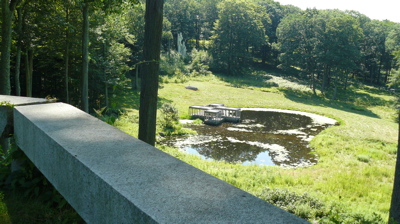
Once inside it, however, one learns that one’s eyes were playing tricks from above. There are no walls, but the off-kilter columns that made it appear small from above play havoc when “inside” the thing. Fun.
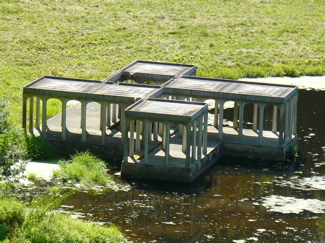
Also down the hill is a giant sculpture thing (for lack of a better word), the twisting 1985 Lincoln Kirstein Tower. I’ll let Richard Lacayo explain:
The concrete stairstep sculpture, 36 ft. tall, that was dedicated to Johnson’s old friend Kirstein, the all purpose aesthete who founded the New York City Ballet with George Balanchine. When Johnson still occupied the grounds visitors were encouraged to climb the tower, but most of them halted halfway. The blocks are barely big enough for your feet and don’t offer much in the way of handholds, and there’s no railings. You get up around 20 feet or so — about where I gave up — and find yourself standing in midair on some precipitous little ledge. Here the danger might have to do with Kirstein’s lifelong personal daring — actually, he had manic episodes — and maybe also with the “stepping” of ballet.
But the Tower is also an outgrowth of Johnson’s concept of “safe danger” in architecture, mildly perilous passages like the stepping stones you navigate across the reflecting pool that separates the two halves of the interior courtyard in the Manhattan guesthouse he designed for Blanchette Rockefeller. But there the worst you might do is miss a stone and wet your Manolo Blahniks. Fall off the Kirstein Tower and you can break your neck. Think of it as a garden folly with edge.
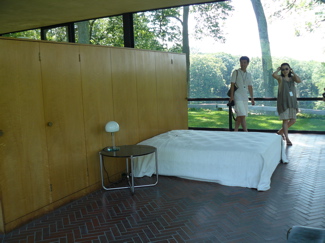
Of course we couldn’t climb the thing, but the above blurb does not mention the coolest part of the sculpture. On the hightest brick at the very top is an inscription. And it’s a secret. Some say only Johnson himself has climbed to the top (though I highly doubt that, since our guide knew what the secret says). Unfortunately I don’t have it for you, but I think it is some bible verse or something equally mundane.
Let’s move on.
Next we went into the earth berm art gallery. Built into the side of the hill, it’s not even really a building but an underground bunker. But once inside, it is well-lit and comfortable. Johnson hung out with a bunch of the more famous 20th century artists like Andy Warhol, Frank Stella and Jasper Johns. He has many originals here, but most are sort of hidden from view because of the way they are presented: On two giant rotating fan-like contraptions that one must make a fairly decent effort to spin around to see new works.
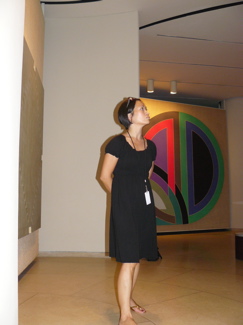
Imagine how cool it would be to be able to walk across your yard and just chill out in an art gallery filled with outsized masterpieces of contemporary artists? No wonder Johnson had so much fun with this place. Oh, and the brownstone used to frame the entryway was leftover from one of Johnson’s New York City skyscrapers. Pretty cool recycling effort old man, pretty cool. (Pink granite from the AT&T Building in NYC was also used somewhere here on the property.)
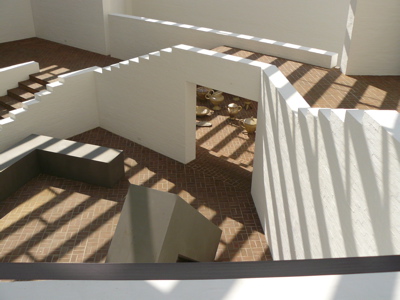
Sculpture Gallery
On to the Sculpture Gallery. Again, built in an entirely different style from the other buildings, this white, fairly open building plays more with sunlight and angles than anything else. I doubt Johnson ever ventured over here on rainy days or during the night. What would be the point? You can see how the sun’s rays filter through the slatted windows to form perhaps the best piece of art in the entire gallery.
These shots remind me of one my mom took of Damian a couple years ago at the pool. Check it out:
I always liked that picture. It’s also interesting that Damian still, at 4, seems fascinated by the play of shadow and light. There’s just something intriguing about it – and little kids aren’t afraid to enjoy and explore it. And neither was Philip Johnson.
I don’t really have any factual information about the various sculptures in the gallery. None of them are too over-the-top goofy as sculpture often is (to me). We were only allowed on the one viewing level, but it certainly gave us a good feeling for Johnson’s genius with light, shadow and sight lines. Even before this point, nearing the end of our 2+ hour tour, I had gained an immense appreciation for why some architects are revered and others are non-entities.
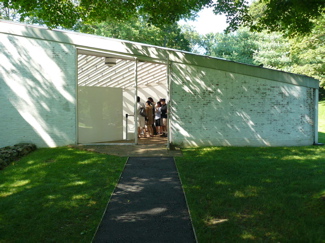
Of course, many don’t have a 47 acre playground and lots of rich friends and money to experiment over the course of 50 years. When one comes to understand and appreciate the scope and depth of what Johnson did here, perhaps with the nudging of an intelligent and influential guide like we had, one can learn a great deal about something they previously thought they hated or didn’t care about.
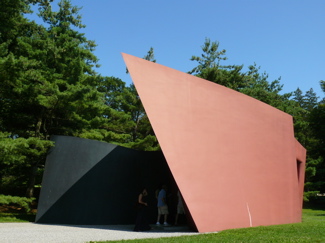
As if the really drive the whole point of Johnson-the-homage-loving-expermentalist, we ended the day at the goofily named Da Monsta. Even the most amateur architectural observer can see Frank Gehry’s influence all over this structure. Designed very late in Johnson’s life (the last building on the property), and supposedly named to sound “hip-hop,” the building currently has no function at all.
Actually, since Johnson knew his property would go to the National Trust and become a museum, this was his Visitor’s Center. Intentionally small, it has a gathering area and a small theater. But New Canaan voted against the idea of all that awful traffic to and fro and hence we have the visitor center a few miles away in a commercial area and an empty Da Monsta.
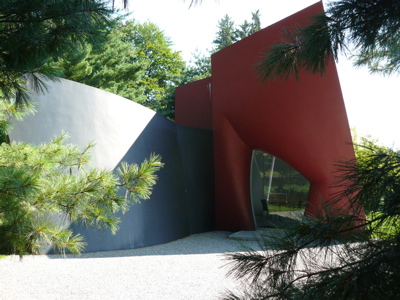
Dislike modern architecture all you want. While it is certainly true that there are many poor examples of mid-century moderns and I can certainly appreciate it if your tastes trend towards Victorian or whatever, I would still encourage you to visit the Glass House property. There is a unique beauty you just aren’t going to find anywhere else in Connecticut. You’ll learn about all the styles of modern architecture over the latter half of the 20th century. You’ll laugh, you’ll learn and maybe – just maybe – you’ll have your mind changed just a little bit.
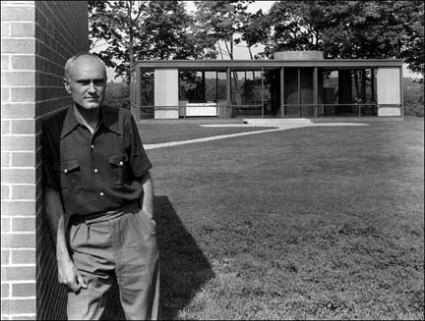
The man and his house, 1949
When you learn that Johnson called the Glass House a “celestial success” because, “When it snows, you seem to be going up, because everything is coming down,” even you, Modern Hater, even you will give pause and think about how beautiful that must be.
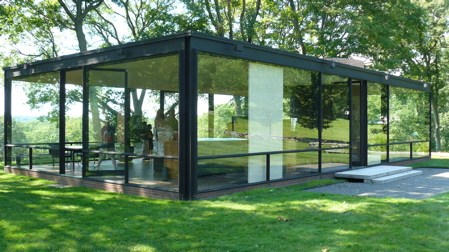
![]()

 martinet says
martinet says
June 22, 2010 at 7:43 amI just think it’s really funny that the day after I read this review, Zippy the Pinhead went to the Glass House.
 James Lindgren says
James Lindgren says
December 27, 2011 at 2:02 amI toured the house in 1971 or 1972 (Goldberger might have made his first visit on the same tour of about a dozen of us). Our professor at Yale, Vincent Scully, offered to take his students on a tour of some houses and public buildings one Saturday. Though there were perhaps 500 students in the class, the small bus he rented was not full. Indeed, my wife tagged along since there were unused slots.
Philip Johnson was there and hosted us at his house. I remember that he was reserved and said very little.
BTW, as I recall, the pavilion is about 2/3rds size. That made the pond look larger and farther away than it was.
Jim Lindgren
Northwestern University